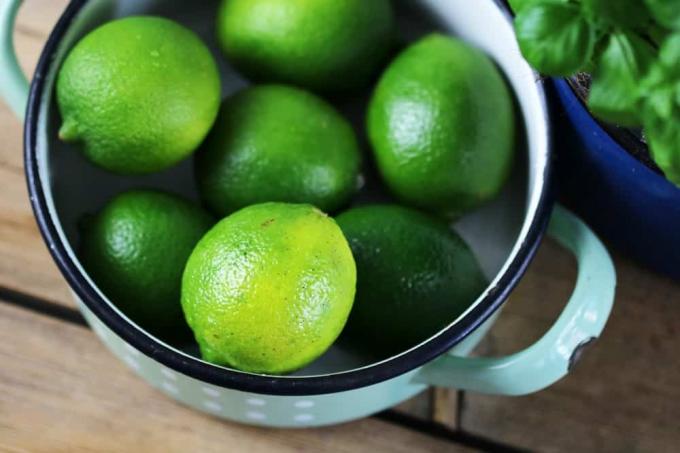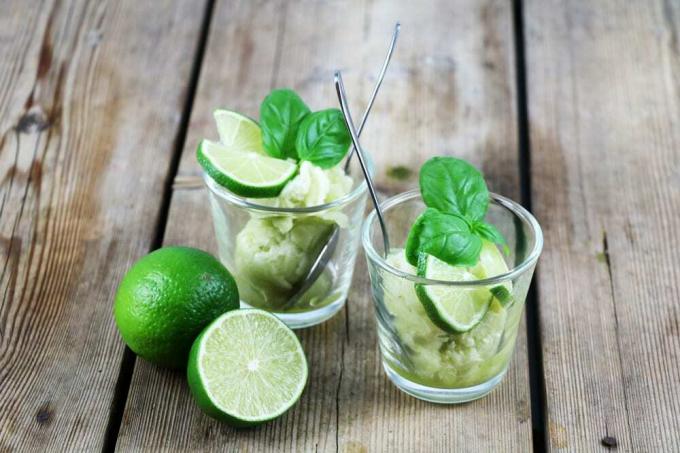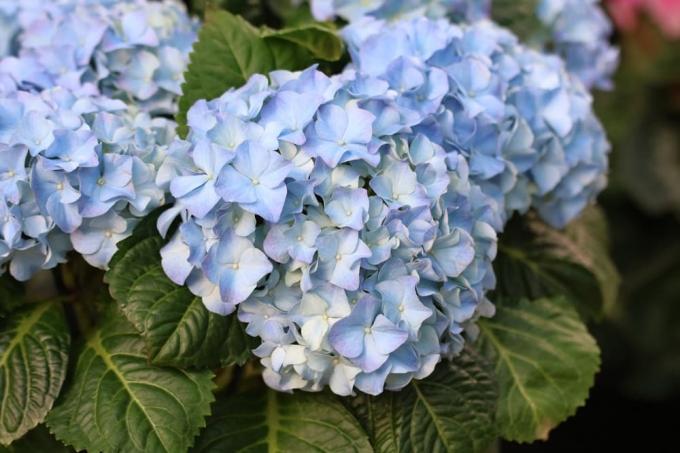

Table of contents
- sorts
- Location
- potting soil
- Pour
- Fertilize
- repot
- topiary
- maintenance cut
- education cut
- propagation
- harvest
- pests
- Diseases
- hibernation phase
- winter quarters
- winter care
- Common grooming mistakes
The lime, the little sister of the lemon, exudes a Mediterranean flair and thus satisfies our longing for faraway places. The strong green leaves look elegant, the small flowers exude an intense scent in summer. And if the care is right, it will also work with the aromatic, yellow-green fruit.
sorts
Limes come in different varieties: cavier lime, Roman lime, tangerine lime and Palestine lime are some of the well-known varieties. All of these varieties have similar care requirements. The Mexican lime expects a lot of warmth and light. It causes problems during the winter and usually needs an additional plant lamp. The common lime (Citrus × latifolia), also known as the Persian lime, is the easiest-to-grow variety of lime.
Location
Unlike in southern climes, where the climate is ideal for all citrus fruits, they only thrive in this country if they are in a suitable location. If this is chosen incorrectly, even the best care will not help. The ideal location for the lime is bright, full sun but still sheltered from the wind. In the warm season, the lime bucket can be placed outside in the garden or on the balcony.
Place the lime plant in such a way that it gets the sun's rays as early and as long as possible. The lime is one of the smallest citrus plants that puts all its energy into the formation of aromatic fruits. Therefore, make sure that other plants or house walls cannot cast any shadows on the lime. The lime always needs some time to get used to when changing location. When going outside, make sure that it is not immediately exposed to intense sunlight. At first, only put the lime out for an hour or so and gradually increase the time.
potting soil
In their homeland, limes grow into small trees in the wild. North of the Alps, it can only be grown in pots or tubs that have sufficient drainage holes in the bottom. Limes need loose, well-drained soil. However, the bottom layer should be a drainage layer of gravel or crushed stone. Ready-mixed citrus soil is available commercially. Cactus soil is also good.
Tip:
You can make your own mix yourself quite cheaply. To do this, mix good garden soil with some sand and crushed gravel or expanded clay.
Pour

The lime plant requires much less water than the lemon, which is more common in our country. So be careful not to overwater out of habit. How much water the lime plant actually needs is primarily determined by its growth. The growth, in turn, can vary and is strongly dependent on the weather. To put it simply: the lime needs water when the upper half of the soil is dry.
It is not enough that the visible surface layer is dry. The layer of soil immediately below may still be wet. If possible, use rainwater as irrigation water. Thoroughly soak the lime root ball with water, then wait several days before watering again.
Tip:
A moisture meter, the probe of which is inserted deep into the ground, can reliably help you to find the right time for watering.
Fertilize
In the period from May to June, the lime delights us with its wonderful white blossoms, before the aromatic fruits are then formed. In this growing season, from spring to summer, their nutrient requirements are highest. The lime plant is fertilized weekly with a special mineral citrus fertilizer. This contains all the necessary nutrients such as nitrogen, calcium, potassium and iron in the right composition.
The fertilizer is dosed according to the packaging instructions and added to the irrigation water. Therefore, only fertilize when the plant needs water. The need for water is also a sure sign that the plant is growing. In this case, fertilization is also appropriate. If you fertilize independently of the water requirement, the risk of over-fertilization is high.
In winter, the lime takes a break from growing and resting. During this time, the lime does not need fertilizer. Stop fertilizing in the fall.
A notice:
Biological fertilizer is less suitable for the lime tree, as its nutrients are only accessible to the plant if they are appropriately converted by microorganisms. However, pot planting is not a particularly good breeding ground for microorganisms.
repot
The limes that are not hardy have to be grown almost exclusively in tubs. Regular repotting is a prerequisite for healthy growth. The right time is February and March. But even after the ice saints, when the limes come outside, repotting is possible. Young plants usually need a larger pot every year, while older trees only need a larger pot every two to three years. Repotting is also necessary when the roots grow out of the drainage holes.
- For repotting, take a pot that is 2-3 cm larger, a clay pot with a hole is ideal
- First put in a drainage layer consisting of gravel or clay pebbles. A few centimeters is enough.
- Put some citrus soil in the pot.
- Compact the soil by jerking the pot up.
- Now place the plant in the middle of the pot and fill in the soil around it.
- Press down the added soil with your fingers.
- Water the plant well.
Tip:
If the lime tree is already in a very large pot, it is sufficient if only the top layer of soil is replaced with fresh soil. Repotting is a stressful situation for the delicate lime plant. It can therefore happen that it loses its leaves afterwards. Don't worry, new leaves will sprout on the branches after a few weeks.
topiary
A lime tree grows quite slowly, so there isn't really much to cut. A regular shape cut is not possible. If the tree is healthy, a drastic pruning is not necessary. If the lime tree is out of shape, it can be pruned like any other fruit tree. The best time for a topiary is at the end of the hibernation phase, when the lime loses the least strength. Proceed as follows when cutting:
- Only use clean and sharp pruning shears
- Disinfect the secateurs with alcohol
- Remove shoots that grow inward
- Remove shoots that cross with other branches
- If necessary, you can remove the light green shoots entirely
- Cut thin branches by a third
- Cut thicker branches by two-thirds
- Shorten the main shoot only so far that it overhangs the side shoots by 10 - 15 cm.
Pruning ensures that enough light can reach the crown, but only trim as much as necessary. No longer!
maintenance cut

During the cold winter, individual branches may die off. You should remove these. The best time for this is also the end of the winter period or early spring at the latest.
- Only use clean and sharp pruning shears
- Disinfect the secateurs with alcohol
- Remove all dead branches and twigs. Cut a little beyond the dead spot into the green wood.
education cut
Young plants should be pruned regularly but gently to allow them to develop a nice bushy crown. The main pruning should be done before the start of a new growing season. If further correction is appropriate during the summer, individual shoots can be pruned in moderation.
propagation
A lime seed can be planted in soil and watered, with a bit of luck it will develop into a plant. However, because the limes offered here often come from hybrid plants, it is possible that the resulting plant is infertile. Unfortunately, you only notice this after about seven years, when you can expect fruit for the first time.
Limes can be safely propagated from cuttings. Propagation by grafting or mossing (root formation on the mother plant) requires a lot of patience and is more for professionals. However, plants propagated in this way bear fruit much earlier.
harvest
The lime fruits are ready to harvest about five to six months after flowering. They are picked when green. However, some varieties have a yellow skin. The fruits are the long-awaited icing on the cake for every lover of these plants. Don't worry, it doesn't have to be maintenance if your lime tree isn't bearing fruit yet. In this country, they take many years to do so. It can even take a full decade for the lime tree to bear fruit.
pests
Lime trees are more susceptible to sucking pests in winter than in summer. Scale, mealybugs, mealybugs and spider mites are the most common and must be dealt with immediately to limit the damage. Commercially available agents are sprayed to combat it. The treatment usually has to be repeated several times, since the pests also live in the ground and are difficult to drive away from there with the agents.
Tip:
You can easily make an environmentally friendly spray against sucking pests yourself by mixing water and some soft soap.
Diseases
Black coating on leaves and dried plant parts are a sure sign of fungal infestation. Depending on how far the infestation has progressed, you can wipe the leaves or cut off the affected branches. Be careful not to spread the fungal disease further. When cutting the diseased parts of the plant, use disposable gloves that you can throw away afterwards.
After cutting, thoroughly clean the cutting tool with water and then disinfect it with alcohol. If the infestation is very severe, the lime can possibly only be saved with the use of chemical agents.
hibernation phase

Limes are not hardy and cannot overwinter outdoors. When the temperatures fall below 12 °C, it is high time for the winter quarters. At the latest, however, when night frosts are to be expected, the lime tree must go in. If the weather permits, it can be out again in April, but at the latest after the Ice Saints.
winter quarters
Lime is believed to originate from areas in India where it is consistently warm and humid. bright rooms or Conservatories facing south and room temperatures around approx. 20 °C and high humidity are well suited for hibernation. A heated greenhouse is also a good winter quarters. Usually, however, only cooler rooms are available. Here it should be ensured that the temperatures do not fall below 5 °C. Even the cool rooms should be bright.
A notice:
Limes do not tolerate direct contact with underfloor heating, which radiates too much heat. The immediate vicinity of radiators should also be avoided.
winter care
Your lime tree will take a break, but maintenance will not. It goes further and only adapts to the demands of winter.
- Limes should never dry out completely, even in the winter quarters. Rinse them with lukewarm water from time to time. The cooler the location, the less water is needed.
- If the lime loses leaves, be particularly economical with watering.
- If the lime has lost all its leaves, stop watering completely.
- Spray limes regularly with water to increase humidity.
- In general, the warmer the lime is, the more light it needs. If the wintering room is cold, it must not be too bright.
- If the ratio of light and heat is not optimal, there is a risk of leaf loss.
- A plant lamp is useful when there is not enough natural light available.
- Fertilizing is not necessary.
- Check your lime tree regularly for pest infestations and diseases. If necessary, take appropriate measures.
If your lime tree does well with the chosen winter location, you can keep it for the next winter. Otherwise, adjustments may need to be made.
A notice:
The lime can react negatively to the change of location in the first few weeks. Hectic reactions are not appropriate. Be patient and wait a while.
Common grooming mistakes
If the lime tree vegetates, in addition to pests and diseases, care errors could also be to blame.
- Curled leaves are a sign of a lack of water, but also a sign of wet roots.
- Iron deficiency turns the leaves yellow. The pH of the soil may be too high and iron cannot be absorbed by the lime. It should be lowered with acidic fertilizers.
- Too little light and too much water lead to soft shoots and so-called monster growth.
- Light and white leaves appear when there is a lack of nutrients due to damaged roots. Too much moisture has led to rot.
- If the root ball is supercooled, the lime sheds leaves and fruit. From autumn, watch out for night frosts and put the lime inside overnight. In the winter quarters, the pot can be placed on Styrofoam, which insulates against the cold ground.
- Premature dropping fruit can also indicate a lack of light.
 garden editorial
garden editorial I write about everything that interests me in my garden.
Learn more about potted plants

Spider Flower, Cleome hassleriana: Care Instructions
Spider flowers get their name from their spider-like appearance. Many hobby gardeners shy away from cultivating the beautiful exotic species. When it comes to maintenance, there are just a few things to keep in mind.

How do I care for a gentian tree? Lycianthes rantonnetii
A gentian tree can be a decorative enrichment both on the balcony and in the garden. For the culture, however, some criteria must be observed. This includes, among other things, the high nutrient content that is required for flowering.

Overwinter pampas grass | 16 tips for winterizing
Pampas grass is a popular ornamental plant in the garden or in tubs, which can be attractively integrated into a wide variety of garden ideas thanks to its decorative fronds. They are considered hardy, but need suitable winter protection in Central Europe due to possible moisture damage.

Leadwort, plumbago: care from A to Z
Leadwort (Plumbago) hides one of the most attractive potted plants of all. The magnificent shrub impresses above all with its blue flowers, which it produces from May to autumn, transforming terraces and balconies into a luminous oasis.

Hydrangeas, rhododendrons and hibiscus smoke | dangers of drugs
Anyone who has cultivated hydrangeas, rhododendrons or hibiscus in the front yard may be surprised that the beautiful flowers were cut off by strangers. Because especially among young people, there is a rumor that these flowers can be smoked and have the effect of marijuana. But this is dangerous information.

Peasant hydrangea, Hydrangea macrophylla - care and pruning
With its attractive, ball-shaped umbels of flowers in white, pink, purple, red or blue, the hydrangea is one of the most decorative garden plants. Here's what you need to know about the farmer's hydrangea so that it blooms and thrives lushly in your garden.



